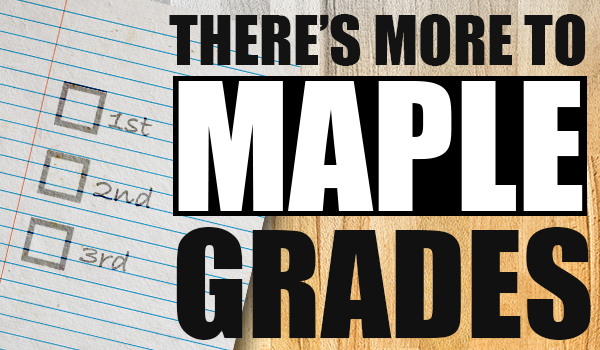
By the time a child reaches elementary school, they will be acutely aware of grades: the A’s, B’s, C’s, D’s, and F’s of academics. As soon as the concept of grades is formed, that student will immediately begin to see grades as a value system. For instance, an A is better than a B, a B is better than a C, and a D or F is unacceptable.
The idea that grades are solely used to determine relative value (ie, this thing is better than that thing) is a preconception that we need to shake off. In the purest sense, grades are just measures, not an arbiter of what is good or bad.
Case in point: MFMA Northern Maple Grades for hardwood flooring. We have been so conditioned to expect “good, better, best” categories from suppliers, that we reflexively apply that outlook, even when it doesn’t completely fit. Is a “First Grade” Northern Maple floor better than a “Second and Better Grade” floor? Structurally, the answer is “no.” Aesthetically, the answer is “maybe.” But, aesthetics are subjective, so you might want a maple court with a little more character. Who is to say which is preferable?
We’re not saying that maple grading categories are useless. In fact, the opposite is true. MFMA grading gives you valuable information that will allow you to make the best choice for your design and budget. Let’s examine each grade in detail to get a better idea of what a particular grade implies.
First Grade: According to the Maple Flooring Manufacturers Association (MFMA), “the highest standard MFMA grade is hand selected to minimize the natural character variations of the species.” First grade maple is essentially the most uniform hardwood surface with minimal distinctive features. This grade gets its “premium” persona from the simple fact that creating an assortment of planks without distinct features is more challenging. It’s important to remember that first grade maple is no different than other grades in terms of structure and stability.
Second and Better Grade: This maple grade is the most commonly used. The MFMA describes Second and Better Grade as having “more natural variations than first grade.” Basically, this grade casts a wider net, incorporating grain and color variations that might not make it in a First Grade selection. Again, Second and Better Grade isn’t a designation of quality. It only signifies an increase in contrast and visual complexity.
Third and Better Grade: “This grade provides the visual variations of third grade combined with the aesthetics of second and better grade.” Third and Better Grade represents the inclusion of more color and pattern differences to the floor. Choosing this grade might be a great way to create a court with character. After all, the sort of variations found in Third and Better Grade maple are what makes hardwood flooring so unique.
Third Grade: According to the MFMA, Third Grade maple has “the same structural integrity as all other grades and exhibits a contrasting natural appearance.” This grade incorporates more variation than any of the other grades. You might say it is natural wood flooring at its most “natural.” Third Grade maple demands a little more courage from a design perspective and perhaps a few restaints. Since a lot of pattern and color contrast risks interfering with the visibility of game lines, Third Grade might be more suitable for an aerobics studio than a basketball court. Nonetheless, this grade has all the “character” you could ever want in a hardwood floor.
Of course, there is a lot more to learn about the process of grading maple floors outside of defining the grades themselves. Maplefloor.org is an excellent resource for understanding the MFMA surfaces. There, you can deep dive into topics like the nuances of color definition as it pertains to grading. You can explore the quality assurance standards that apply or learn about plank length in relation to grading.
Robbins is the MFMA manufacturing member that supplies the hardwood floors provided by Abacus Sports Installations. If you would like more information about Robbins hardwood courts, contact us or visit the Robbins website for more information.
